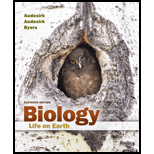
Concept explainers
Which of the following does not characterize the tropical rain-forest biome?
a. warm temperatures year-round
b. abundant rainfall
c. nutrient-rich soil
d. high biodiversity
Introduction:
Tropical rainforests are situated along the equator of the earth. Here, temperature ranges in between 25°C and 30°C throughout the year. These forests are compactly packed with tall broadleaf evergreen trees and are highly rich in biodiversity. They are estimated to contain half of the world’s biodiversity. These forests experience 100–160 inches of rainfall every year.
Answer to Problem 1MC
Correct answer:
Plants and trees are dependent on nutrients present in the soil for their growth and maintenance.
Explanation of Solution
Explanation for the correct answer:
Option (c) is given that tropical rainforests are not characterized by nutrient-rich soil. In the tropical rainforest, nutrients from the soil are accumulated in its vegetation at a very fast rate due to very high demand and dense population. However, on the other hand, replenishment of these nutrients back into the soil is limited, partly, because of limited sunlight and high competition for nutrients among animals. Therefore, these conditions result in the nutrient-depleted soil which is mostly infertile in nature. Hence, option (c) is correct.
Explanation for incorrect answer:
Option (a) is given that tropical rainforests are not characterized by warm temperatures year-round. But, the temperature in tropical rainforest ranges in between 25°C and 30°C throughout the year which can be regarded as warm temperature. So, it is an incorrect option.
Option (b) is given that tropical rainforests are not characterized by abundant rainfall. But, these forests experience 100–160 inches of rainfall every year which is very high as compared to other areas on the earth. So, it is an incorrect option.
Option (d) is given that tropical rainforests are not characterized by high biodiversity. But, scientists have estimated that tropical rainforests contain almost half of the world’s biodiversity. So, it is an incorrect option.
Therefore, it can be concluded that the tropical rainforests are characterized by warm temperature and high rainfall throughout the year. These forests are rich in biodiversity but poor in terms of nutrients in the soil.
Want to see more full solutions like this?
Chapter 30 Solutions
Biology: Life on Earth (11th Edition)
- Molecular Biology You discover a disease causing mutation (indicated by the arrow) that alters splicing of its mRNA. This mutation (a base substitution in the splicing sequence) eliminates a 3’ splice site resulting in the inclusion of the second intron (I2) in the final mRNA. We are going to pretend that this intron is short having only 15 nucleotides (most introns are much longer so this is just to make things simple) with the following sequence shown below in bold. The ( ) indicate the reading frames in the exons; the included intron 2 sequences are in bold. A. Would you expected this change to be harmful? ExplainB. If you were to do gene therapy to fix this problem, briefly explain what type of gene therapy youwould use to correct this. Please help. Thank youarrow_forwardMolecular Biology Question Please help. Thank you Explain what is meant by the term “defective virus.” Explain how a defective virus is able to replicate.arrow_forwardMolecular Biology Explain why changing the codon GGG to GGA should not be harmful. Please help . Thank youarrow_forward
- Stage Percent Time in Hours Interphase .60 14.4 Prophase .20 4.8 Metaphase .10 2.4 Anaphase .06 1.44 Telophase .03 .72 Cytukinesis .01 .24 Can you summarize the results in the chart and explain which phases are faster and why the slower ones are slow?arrow_forwardCan you circle a cell in the different stages of mitosis? 1.prophase 2.metaphase 3.anaphase 4.telophase 5.cytokinesisarrow_forwardWhich microbe does not live part of its lifecycle outside humans? A. Toxoplasma gondii B. Cytomegalovirus C. Francisella tularensis D. Plasmodium falciparum explain your answer thoroughly.arrow_forward
- Select all of the following that the ablation (knockout) or ectopoic expression (gain of function) of Hox can contribute to. Another set of wings in the fruit fly, duplication of fingernails, ectopic ears in mice, excess feathers in duck/quail chimeras, and homeosis of segment 2 to jaw in Hox2a mutantsarrow_forwardSelect all of the following that changes in the MC1R gene can lead to: Changes in spots/stripes in lizards, changes in coat coloration in mice, ectopic ear formation in Siberian hamsters, and red hair in humansarrow_forwardPleiotropic genes are genes that (blank) Cause a swapping of organs/structures, are the result of duplicated sets of chromosomes, never produce protein products, and have more than one purpose/functionarrow_forward
- A loss of function mutation in Pitx1 enhancers can cause (blank) Removal of Pitx1 exons and growth of ectopic hindlimbs, growth of extra ectopic forelimbs, loss of forelimb specification and development, and loss of hindlimb specification and developmentarrow_forwardHox1a most likely contributes to (blank) patterning in the developing embryo? Ventral, posterior, limb or anteriorarrow_forwardSelect all of the following that can help establish Hox gene expression boundaries (things that affect Hox and not things that Hox affects). Retinoic acid, anterior/posterior axis, fibroblast growth factors, vagal neural crest, and enhancersarrow_forward
 Biology (MindTap Course List)BiologyISBN:9781337392938Author:Eldra Solomon, Charles Martin, Diana W. Martin, Linda R. BergPublisher:Cengage Learning
Biology (MindTap Course List)BiologyISBN:9781337392938Author:Eldra Solomon, Charles Martin, Diana W. Martin, Linda R. BergPublisher:Cengage Learning
 Concepts of BiologyBiologyISBN:9781938168116Author:Samantha Fowler, Rebecca Roush, James WisePublisher:OpenStax College
Concepts of BiologyBiologyISBN:9781938168116Author:Samantha Fowler, Rebecca Roush, James WisePublisher:OpenStax College Biology 2eBiologyISBN:9781947172517Author:Matthew Douglas, Jung Choi, Mary Ann ClarkPublisher:OpenStax
Biology 2eBiologyISBN:9781947172517Author:Matthew Douglas, Jung Choi, Mary Ann ClarkPublisher:OpenStax Human Biology (MindTap Course List)BiologyISBN:9781305112100Author:Cecie Starr, Beverly McMillanPublisher:Cengage Learning
Human Biology (MindTap Course List)BiologyISBN:9781305112100Author:Cecie Starr, Beverly McMillanPublisher:Cengage Learning Biology: The Dynamic Science (MindTap Course List)BiologyISBN:9781305389892Author:Peter J. Russell, Paul E. Hertz, Beverly McMillanPublisher:Cengage Learning
Biology: The Dynamic Science (MindTap Course List)BiologyISBN:9781305389892Author:Peter J. Russell, Paul E. Hertz, Beverly McMillanPublisher:Cengage Learning





